Related Research Articles

The Southeast Asia Treaty Organization (SEATO) was an international organization for collective defense in Southeast Asia created by the Southeast Asia Collective Defense Treaty signed in September 1954 in Manila, Philippines. The formal institution of SEATO was established on 19 February 1955 at a meeting of treaty partners in Bangkok, Thailand. The organization's headquarters was also in Bangkok. Eight members joined the organization.

Pote Sarasin was the ninth prime minister of Thailand from September 1957 to December 1957. He belonged to the influential Sarasin family. He served as foreign minister from 1949 to 1950 and then served as ambassador to the United States. In September 1957 when Sarit Thanarat seized power in a military coup, he appointed Pote to be the Prime Minister of Thailand. He resigned in December 1957. Pote also served as the first Secretary General of the Southeast Asia Treaty Organization from September 1957 until 1963.
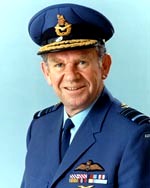
Air Marshal Sir James Anthony Rowland, was a senior commander in the Royal Australian Air Force (RAAF), serving as Chief of the Air Staff (CAS) from 1975 to 1979. He held office as Governor of New South Wales from 1981 to 1989, and was Chancellor of the University of Sydney from 1990 to 1991.
Chief of Air Force (CAF) is the most senior appointment in the Royal Australian Air Force (RAAF), responsible to the Chief of the Defence Force (CDF) and the Secretary of the Department of Defence. The rank associated with the position is air marshal (three-star). The role encompasses "the delivery of aerospace capability, enhancing the Air Force's reputation and positioning the Air Force for the future". It does not include direction of air operations, which is the purview of the Air Commander Australia, a two-star position responsible directly to CDF in such circumstances but nominally reporting to CAF.

Air Chief Marshal Sir Neville Patrick McNamara, was a senior commander of the Royal Australian Air Force (RAAF). He served as Chief of the Air Staff (CAS), the RAAF's highest-ranking position, from 1979 until 1982, and as Chief of the Defence Force Staff (CDFS), Australia's top military role at the time, from 1982 until 1984. He was the second RAAF officer to hold the rank of air chief marshal.

Air Vice Marshal William Dowling Bostock, was a senior commander in the Royal Australian Air Force (RAAF). During World War II he led RAAF Command, the Air Force's main operational formation, with responsibility for the defence of Australia and air offensives against Japanese targets in the South West Pacific Area. His achievements in the role earned him the Distinguished Service Order and the American Medal of Freedom. General Douglas MacArthur described him as "one of the world's most successful airmen".

Air Marshal Sir Valston Eldridge Hancock, was a senior commander in the Royal Australian Air Force (RAAF). He served as Chief of the Air Staff from 1961 to 1965. A graduate of the Royal Military College, Duntroon, Hancock transferred from the Army to the RAAF in 1929 and qualified as a pilot. His administrative training at Duntroon saw him mainly occupy staff posts, including Deputy Director of Operations and Intelligence at RAAF Headquarters from 1931 to 1935, and Director of Works and Buildings from 1937 to 1939. During the early years of World War II, he commanded No. 1 Bombing and Gunnery School, and held senior planning and administrative positions. He eventually saw combat in the Aitape–Wewak campaign of the Pacific War during 1945. Flying Bristol Beaufort light bombers, he led first No. 100 Squadron, and later No. 71 Wing. His actions earned him the Distinguished Flying Cross.

Air Marshal Sir Colin Thomas Hannah, was a senior commander in the Royal Australian Air Force (RAAF) and a Governor of Queensland. Born in Western Australia, he was a member of the Militia before joining the RAAF in 1935. After graduating as a pilot, Hannah served in Nos. 22 and 23 Squadrons from 1936 to 1939. During the early years of World War II, he was the RAAF's Deputy Director of Armament. He then saw action in the South West Pacific as commander of No. 6 Squadron and, later, No. 71 Wing, operating Bristol Beaufort bombers. By 1944, he had risen to the rank of group captain, and at the end of the war was in charge of Western Area Command in Perth.
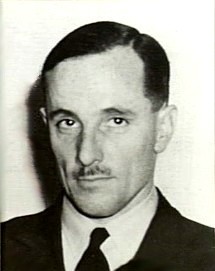
Air Vice-Marshal Joseph Eric Hewitt, was a senior commander in the Royal Australian Air Force (RAAF). He joined the Royal Australian Navy in 1915, and transferred permanently to the Air Force in 1928. Hewitt commanded No. 101 Flight in the early 1930s, and No. 104 (Bomber) Squadron RAF on exchange in Britain shortly before World War II. He was appointed the RAAF's Assistant Chief of the Air Staff in 1941. The following year he was posted to Allied Air Forces Headquarters, South West Pacific Area, as Director of Intelligence. In 1943, he took command of No. 9 Operational Group, the RAAF's main mobile strike force, but was controversially sacked by the Chief of the Air Staff, Air Vice Marshal George Jones, less than a year later over alleged morale and disciplinary issues.
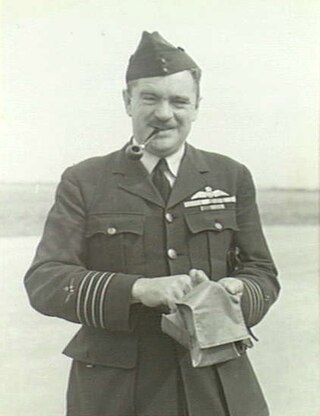
Air Commodore Francis William Fellowes (Frank) Lukis, CBE was a senior commander in the Royal Australian Air Force (RAAF). A veteran of World War I, he first saw combat as a soldier in the Australian Imperial Force at Gallipoli. In 1917, Lukis transferred to the Australian Flying Corps and flew with No. 1 Squadron in the Middle East, where he was twice mentioned in despatches. A member of the Australian Air Corps following the war, he transferred to the fledgling RAAF in 1921, and became the first commanding officer of the newly re-formed No. 3 Squadron at RAAF Station Richmond, New South Wales, in 1925.

Air Marshal John William "Jake" Newham, AC was a senior commander of the Royal Australian Air Force (RAAF). He served as Chief of the Air Staff (CAS) from 1985 until 1987. Joining the RAAF in 1951, he flew Gloster Meteor jets with No. 77 Squadron in the Korean War in 1953, and subsequently de Havilland Vampires with No. 78 Wing on garrison duty in Malta. From 1958 to 1960, he served with No. 3 Squadron, operating CAC Sabres during the Malayan Emergency. He took charge of No. 3 Squadron in 1967, when it re-equipped with the Dassault Mirage III supersonic fighter. His commands in the early 1970s included the Aircraft Research and Development Unit, RAAF Base Laverton, and No. 82 Wing, the last-mentioned during its first years operating the long-delayed General Dynamics F-111C swing-wing bomber. He was appointed Deputy Chief of the Air Staff in March 1984, and CAS in May the following year. His tenure as CAS coincided with the release of the Dibb Report on Australia's defence capabilities, and the controversial transfer of the RAAF's battlefield helicopters to the Australian Army. Newham retired from the Air Force in July 1987 and became a company director.
Air Marshal Raymond George (Ray) Funnell, is a retired senior commander of the Royal Australian Air Force (RAAF). He served as Chief of the Air Staff (CAS) from 1987 until 1992. A graduate of RAAF College, he began his career flying CAC Sabre jet fighters in Australia and South East Asia in the 1950s and 1960s. From 1972 to 1975 he commanded No. 6 Squadron, during which time the General Dynamics F-111C swing-wing bomber entered Australian service. He held senior staff posts in the early 1980s. In 1986, he was promoted to air marshal and became the inaugural Vice Chief of the Defence Force. Appointed CAS in July 1987, Funnell was closely involved in the development and dissemination of air power doctrine. He retired from the RAAF in October 1992 following his term as CAS, and was founding Principal of the Australian College of Defence and Strategic Studies from 1994 to 1998. Since then he has served on various Federal Government committees on immigration and detention.

Air Vice Marshal Allan Leslie Walters, CB, CBE, AFC was a senior commander in the Royal Australian Air Force (RAAF). Born in Victoria and raised in Western Australia, he graduated from the Royal Military College, Duntroon, before transferring to the RAAF in 1928. He was one of the service's leading flying instructors and aerobatic pilots between the wars, and was appointed to his first squadron command in 1937. Over the course of World War II, Walters led No. 1 Squadron in Singapore, No. 1 (Fighter) Wing in Darwin, Northern Territory, No. 72 Wing in Dutch New Guinea, and Northern Command in Papua New Guinea. He was decorated with the Air Force Cross in 1941 for his work with No. 1 Squadron, and mentioned in despatches in 1944 for his service with No. 72 Wing.

Air Vice Marshal Ian Dougald McLachlan, CB, CBE, DFC was a senior commander in the Royal Australian Air Force (RAAF). Born in Melbourne, he was a cadet at the Royal Military College, Duntroon, before joining the Air Force in December 1930. After serving in instructional and general flying roles, he took command of No. 3 Squadron in December 1939, leading it into action in the Middle East less than a year later. Awarded the Distinguished Flying Cross, he returned to Australia in 1942 to command air bases in Canberra and Melbourne. The following year he was posted to the South West Pacific, where he led successively Nos. 71 and 73 Wings. Having been promoted to group captain, he took charge of Southern Area Command in 1944, and No. 81 Wing in the Dutch East Indies the following year.

Air Commodore Peter Frank Raw, was a senior officer and pilot in the Royal Australian Air Force (RAAF). He saw combat in a heavy bomber unit in the European theatre during the later stages of World War II and as a senior officer in the Vietnam War, and served in many flying, training and administrative roles.
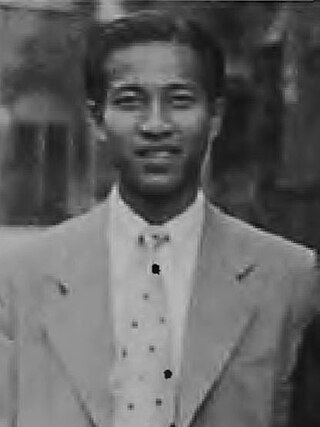
Pong Sarasin was a Thai businessman and politician, who served under Major General Chatichai Choonhavan's cabinet, acting as Deputy Prime Minister along with General Tienchai Sirisumpan in 1988.

Air Vice Marshal William Lloyd Hely, CB, CBE, AFC was a senior commander in the Royal Australian Air Force (RAAF). He graduated from the Royal Military College, Duntroon, in 1930 before transferring to the RAAF as a cadet pilot. Hely came to public attention in 1936–37, first when he crashed on a survey flight in the Northern Territory, and later when he undertook two successful missions to locate missing aircraft in the same vicinity. His rescue efforts earned him the Air Force Cross. After occupying staff positions during the early years of World War II, Hely was appointed Officer Commanding No. 72 Wing in Dutch New Guinea in May 1944. Later that year he formed No. 84 Wing, commanding it during the Bougainville campaign until the end of the Pacific War.
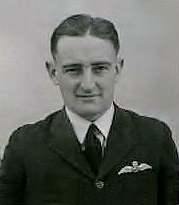
Air Vice Marshal Frank Headlam, was a senior commander in the Royal Australian Air Force (RAAF). Born and educated in Tasmania, he joined the RAAF as an air cadet in January 1934. He specialised in flying instruction and navigation before the outbreak of World War II. In April 1941, he became commanding officer of No. 2 Squadron, which operated Lockheed Hudsons. The squadron was deployed to Dutch Timor in December, and saw action against Japanese forces in the South West Pacific. After returning to Australia in February 1942, Headlam held staff appointments and training commands, finishing the war a group captain.
David Williamson McNicol was an Australian public servant and diplomat.

The Air Board, also known as the Administrative Air Board, or the Air Board of Administration, was the controlling body of the Royal Australian Air Force (RAAF) from 1921 to 1976. It was composed of senior RAAF officers as well as some civilian members, and chaired by the Chief of the Air Staff (CAS). The CAS was the operational head of the Air Force, and the other board members were responsible for specific areas of the service such as personnel, supply, engineering, and finance. Originally based in Melbourne, the board relocated to Canberra in 1961.
References
- ↑ "WORTH, WILLIAM - Royal Australian Air Force". World War Two Nominal Roll. Australian Government. Retrieved 11 January 2016.
- 1 2 3 "Australian Acting SEATO Head". The Canberra Times. ACT: National Library of Australia. 14 December 1963. p. 3. Retrieved 12 January 2016.
- ↑ "Minister Congratulates Mr. Worth". The Canberra Times. ACT: National Library of Australia. 13 July 1957. p. 2. Retrieved 12 January 2016.
- ↑ "Mr. Worth To Take Over SEATO Post". The Canberra Times . ACT: National Library of Australia. 25 September 1957. p. 2. Retrieved 12 January 2016.
- ↑ "WORTH, William - The Order of the British Empire - Officer (Civil)". It's an Honour database. Australian Government. 11 June 1977. Retrieved 11 January 2016.
- ↑ Australia: "No. 47236". The London Gazette (Supplement). 10 June 1977. p. 7122.